Childhood Development: Adversity, Risk, and Resilience (HCS321)
VerifiedAdded on 2022/09/14
|12
|2765
|15
Essay
AI Summary
This essay examines the profound impact of adversity on childhood development, focusing on the psychological and social consequences of adverse experiences. It begins by introducing the topic and emphasizing the lasting effects of early childhood events. The essay then delves into key concepts and theories such as cognitive development theory, attachment theory, and ecological systems theory, providing a framework for understanding how children's mental and emotional development is shaped by their environment. It explores how children respond to adversity and the potential for lifelong problems. The discussion includes the contexts of cultural identity, gender, disability, loss, grief, trauma, displacement, and social isolation, highlighting their influence on children's well-being. The essay uses practical examples to illustrate these concepts, such as the impact of trauma and disability. Finally, the conclusion summarizes the key arguments, emphasizing the critical role of early childhood experiences in shaping brain development and future outcomes. The essay underlines the importance of understanding these factors to support children's resilience and promote positive development.
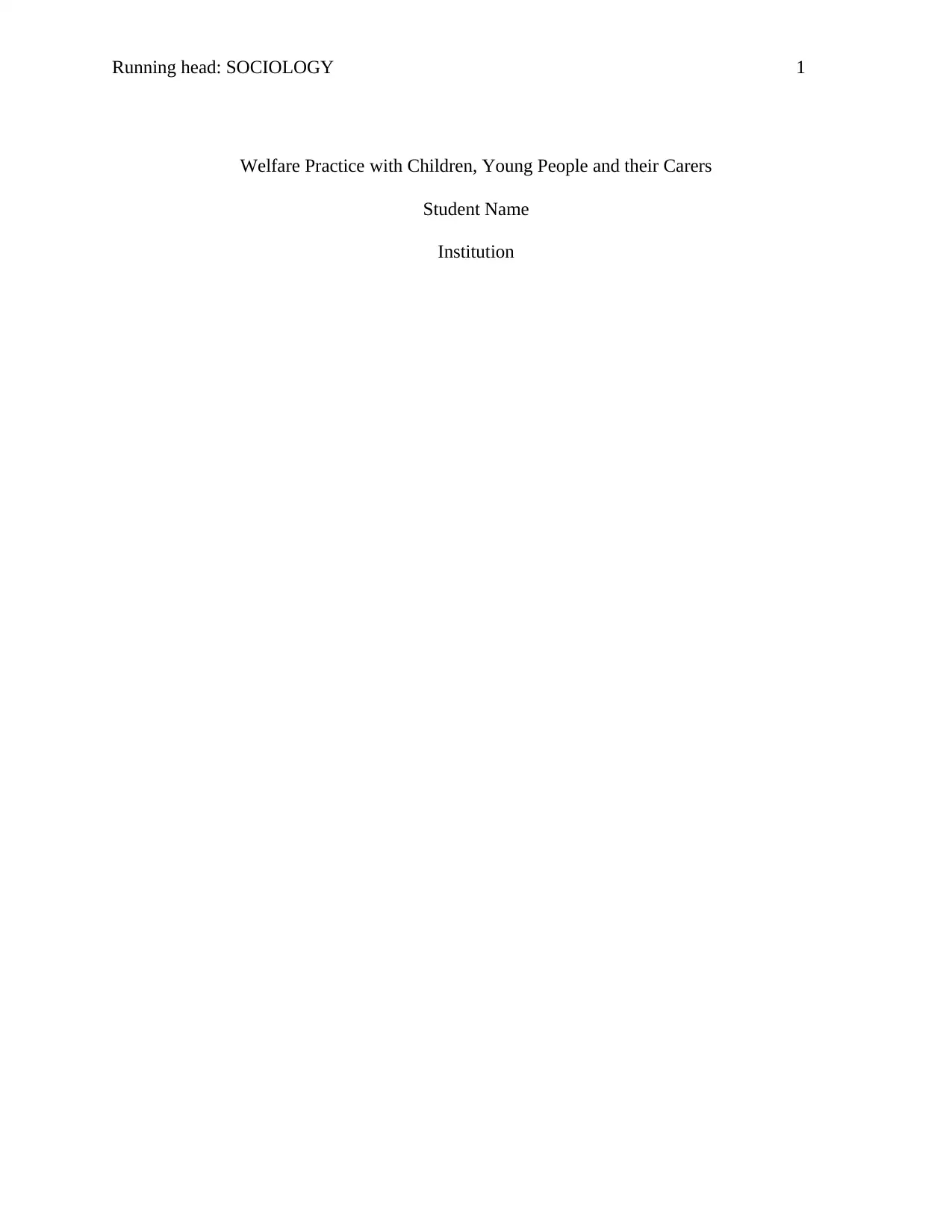
Running head: SOCIOLOGY 1
Welfare Practice with Children, Young People and their Carers
Student Name
Institution
Welfare Practice with Children, Young People and their Carers
Student Name
Institution
Paraphrase This Document
Need a fresh take? Get an instant paraphrase of this document with our AI Paraphraser
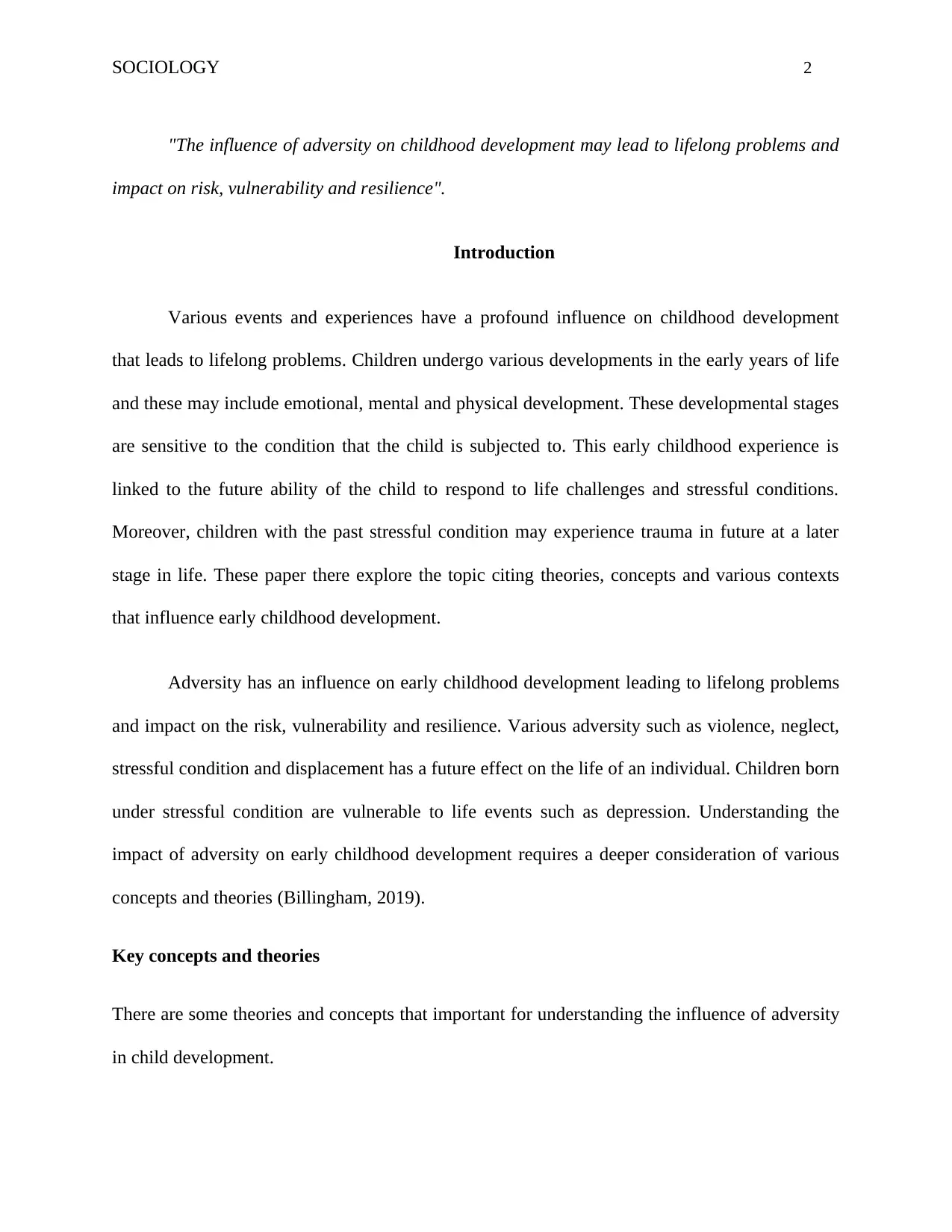
SOCIOLOGY 2
"The influence of adversity on childhood development may lead to lifelong problems and
impact on risk, vulnerability and resilience".
Introduction
Various events and experiences have a profound influence on childhood development
that leads to lifelong problems. Children undergo various developments in the early years of life
and these may include emotional, mental and physical development. These developmental stages
are sensitive to the condition that the child is subjected to. This early childhood experience is
linked to the future ability of the child to respond to life challenges and stressful conditions.
Moreover, children with the past stressful condition may experience trauma in future at a later
stage in life. These paper there explore the topic citing theories, concepts and various contexts
that influence early childhood development.
Adversity has an influence on early childhood development leading to lifelong problems
and impact on the risk, vulnerability and resilience. Various adversity such as violence, neglect,
stressful condition and displacement has a future effect on the life of an individual. Children born
under stressful condition are vulnerable to life events such as depression. Understanding the
impact of adversity on early childhood development requires a deeper consideration of various
concepts and theories (Billingham, 2019).
Key concepts and theories
There are some theories and concepts that important for understanding the influence of adversity
in child development.
"The influence of adversity on childhood development may lead to lifelong problems and
impact on risk, vulnerability and resilience".
Introduction
Various events and experiences have a profound influence on childhood development
that leads to lifelong problems. Children undergo various developments in the early years of life
and these may include emotional, mental and physical development. These developmental stages
are sensitive to the condition that the child is subjected to. This early childhood experience is
linked to the future ability of the child to respond to life challenges and stressful conditions.
Moreover, children with the past stressful condition may experience trauma in future at a later
stage in life. These paper there explore the topic citing theories, concepts and various contexts
that influence early childhood development.
Adversity has an influence on early childhood development leading to lifelong problems
and impact on the risk, vulnerability and resilience. Various adversity such as violence, neglect,
stressful condition and displacement has a future effect on the life of an individual. Children born
under stressful condition are vulnerable to life events such as depression. Understanding the
impact of adversity on early childhood development requires a deeper consideration of various
concepts and theories (Billingham, 2019).
Key concepts and theories
There are some theories and concepts that important for understanding the influence of adversity
in child development.
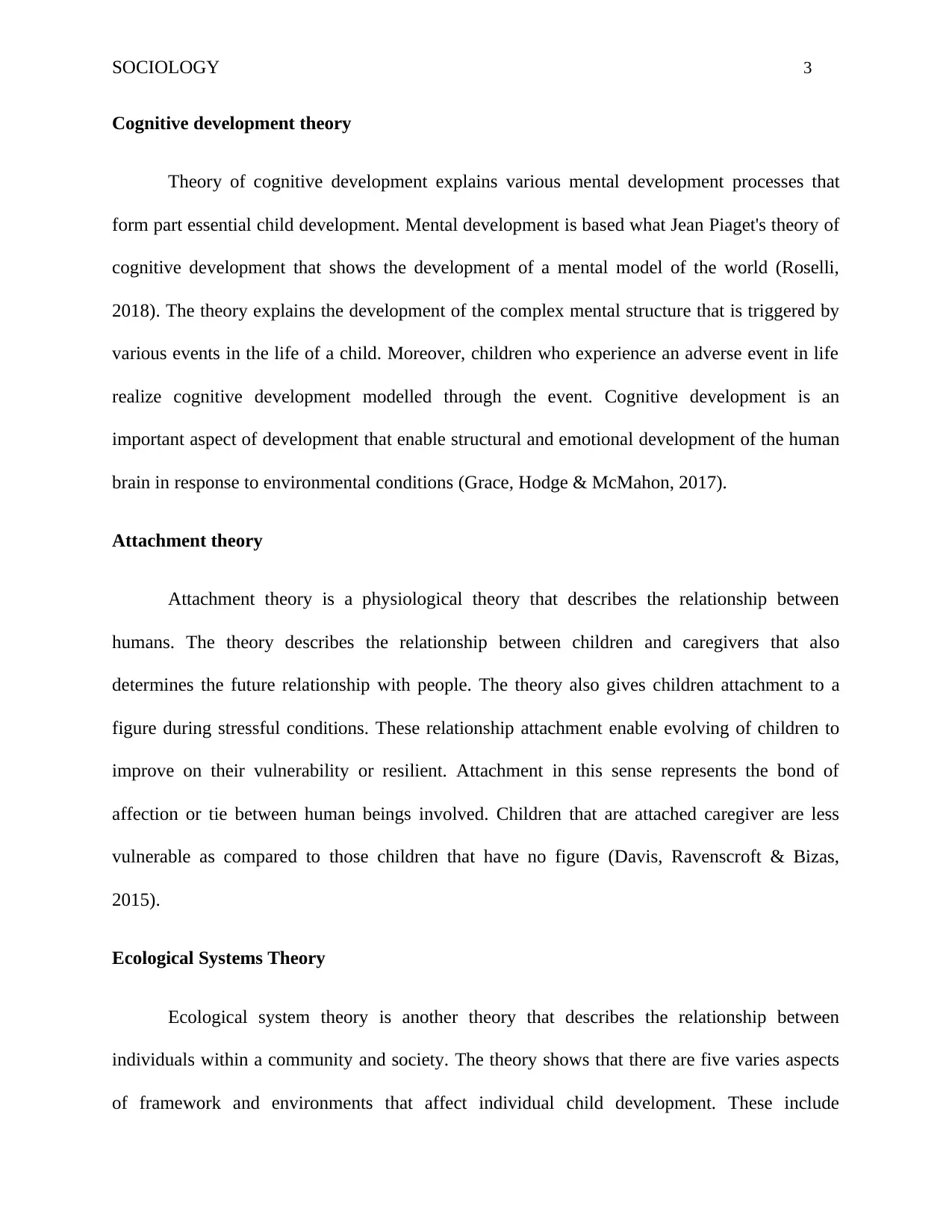
SOCIOLOGY 3
Cognitive development theory
Theory of cognitive development explains various mental development processes that
form part essential child development. Mental development is based what Jean Piaget's theory of
cognitive development that shows the development of a mental model of the world (Roselli,
2018). The theory explains the development of the complex mental structure that is triggered by
various events in the life of a child. Moreover, children who experience an adverse event in life
realize cognitive development modelled through the event. Cognitive development is an
important aspect of development that enable structural and emotional development of the human
brain in response to environmental conditions (Grace, Hodge & McMahon, 2017).
Attachment theory
Attachment theory is a physiological theory that describes the relationship between
humans. The theory describes the relationship between children and caregivers that also
determines the future relationship with people. The theory also gives children attachment to a
figure during stressful conditions. These relationship attachment enable evolving of children to
improve on their vulnerability or resilient. Attachment in this sense represents the bond of
affection or tie between human beings involved. Children that are attached caregiver are less
vulnerable as compared to those children that have no figure (Davis, Ravenscroft & Bizas,
2015).
Ecological Systems Theory
Ecological system theory is another theory that describes the relationship between
individuals within a community and society. The theory shows that there are five varies aspects
of framework and environments that affect individual child development. These include
Cognitive development theory
Theory of cognitive development explains various mental development processes that
form part essential child development. Mental development is based what Jean Piaget's theory of
cognitive development that shows the development of a mental model of the world (Roselli,
2018). The theory explains the development of the complex mental structure that is triggered by
various events in the life of a child. Moreover, children who experience an adverse event in life
realize cognitive development modelled through the event. Cognitive development is an
important aspect of development that enable structural and emotional development of the human
brain in response to environmental conditions (Grace, Hodge & McMahon, 2017).
Attachment theory
Attachment theory is a physiological theory that describes the relationship between
humans. The theory describes the relationship between children and caregivers that also
determines the future relationship with people. The theory also gives children attachment to a
figure during stressful conditions. These relationship attachment enable evolving of children to
improve on their vulnerability or resilient. Attachment in this sense represents the bond of
affection or tie between human beings involved. Children that are attached caregiver are less
vulnerable as compared to those children that have no figure (Davis, Ravenscroft & Bizas,
2015).
Ecological Systems Theory
Ecological system theory is another theory that describes the relationship between
individuals within a community and society. The theory shows that there are five varies aspects
of framework and environments that affect individual child development. These include
⊘ This is a preview!⊘
Do you want full access?
Subscribe today to unlock all pages.

Trusted by 1+ million students worldwide
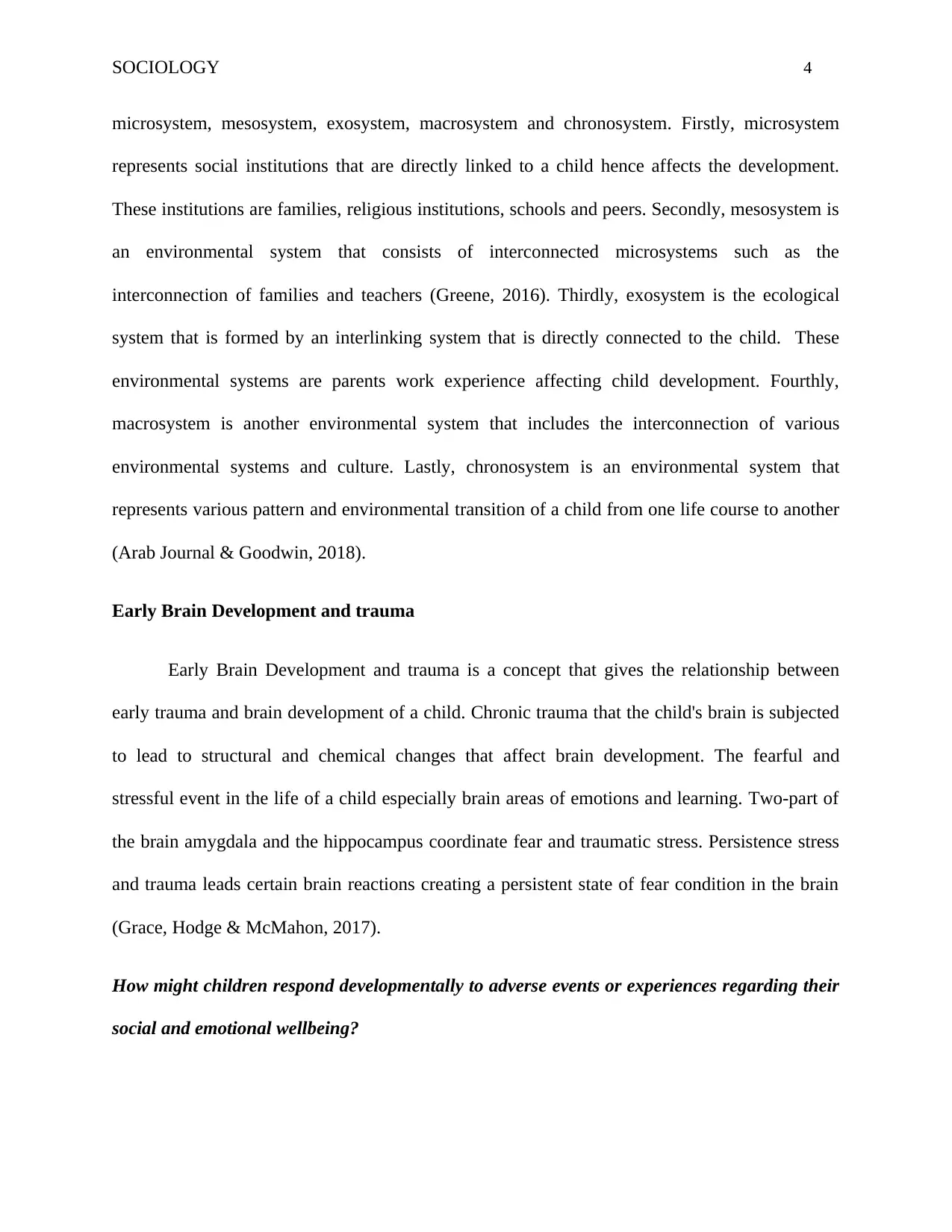
SOCIOLOGY 4
microsystem, mesosystem, exosystem, macrosystem and chronosystem. Firstly, microsystem
represents social institutions that are directly linked to a child hence affects the development.
These institutions are families, religious institutions, schools and peers. Secondly, mesosystem is
an environmental system that consists of interconnected microsystems such as the
interconnection of families and teachers (Greene, 2016). Thirdly, exosystem is the ecological
system that is formed by an interlinking system that is directly connected to the child. These
environmental systems are parents work experience affecting child development. Fourthly,
macrosystem is another environmental system that includes the interconnection of various
environmental systems and culture. Lastly, chronosystem is an environmental system that
represents various pattern and environmental transition of a child from one life course to another
(Arab Journal & Goodwin, 2018).
Early Brain Development and trauma
Early Brain Development and trauma is a concept that gives the relationship between
early trauma and brain development of a child. Chronic trauma that the child's brain is subjected
to lead to structural and chemical changes that affect brain development. The fearful and
stressful event in the life of a child especially brain areas of emotions and learning. Two-part of
the brain amygdala and the hippocampus coordinate fear and traumatic stress. Persistence stress
and trauma leads certain brain reactions creating a persistent state of fear condition in the brain
(Grace, Hodge & McMahon, 2017).
How might children respond developmentally to adverse events or experiences regarding their
social and emotional wellbeing?
microsystem, mesosystem, exosystem, macrosystem and chronosystem. Firstly, microsystem
represents social institutions that are directly linked to a child hence affects the development.
These institutions are families, religious institutions, schools and peers. Secondly, mesosystem is
an environmental system that consists of interconnected microsystems such as the
interconnection of families and teachers (Greene, 2016). Thirdly, exosystem is the ecological
system that is formed by an interlinking system that is directly connected to the child. These
environmental systems are parents work experience affecting child development. Fourthly,
macrosystem is another environmental system that includes the interconnection of various
environmental systems and culture. Lastly, chronosystem is an environmental system that
represents various pattern and environmental transition of a child from one life course to another
(Arab Journal & Goodwin, 2018).
Early Brain Development and trauma
Early Brain Development and trauma is a concept that gives the relationship between
early trauma and brain development of a child. Chronic trauma that the child's brain is subjected
to lead to structural and chemical changes that affect brain development. The fearful and
stressful event in the life of a child especially brain areas of emotions and learning. Two-part of
the brain amygdala and the hippocampus coordinate fear and traumatic stress. Persistence stress
and trauma leads certain brain reactions creating a persistent state of fear condition in the brain
(Grace, Hodge & McMahon, 2017).
How might children respond developmentally to adverse events or experiences regarding their
social and emotional wellbeing?
Paraphrase This Document
Need a fresh take? Get an instant paraphrase of this document with our AI Paraphraser
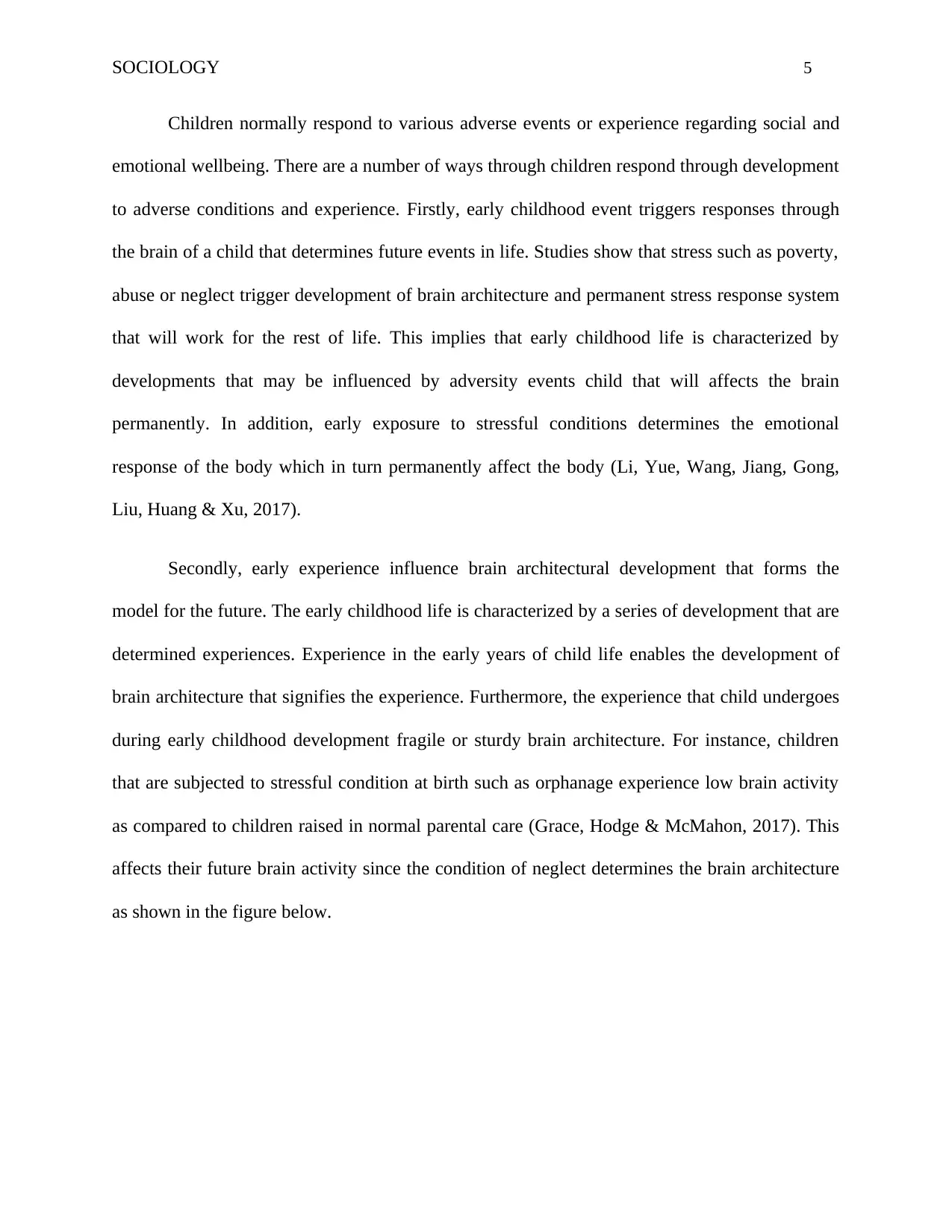
SOCIOLOGY 5
Children normally respond to various adverse events or experience regarding social and
emotional wellbeing. There are a number of ways through children respond through development
to adverse conditions and experience. Firstly, early childhood event triggers responses through
the brain of a child that determines future events in life. Studies show that stress such as poverty,
abuse or neglect trigger development of brain architecture and permanent stress response system
that will work for the rest of life. This implies that early childhood life is characterized by
developments that may be influenced by adversity events child that will affects the brain
permanently. In addition, early exposure to stressful conditions determines the emotional
response of the body which in turn permanently affect the body (Li, Yue, Wang, Jiang, Gong,
Liu, Huang & Xu, 2017).
Secondly, early experience influence brain architectural development that forms the
model for the future. The early childhood life is characterized by a series of development that are
determined experiences. Experience in the early years of child life enables the development of
brain architecture that signifies the experience. Furthermore, the experience that child undergoes
during early childhood development fragile or sturdy brain architecture. For instance, children
that are subjected to stressful condition at birth such as orphanage experience low brain activity
as compared to children raised in normal parental care (Grace, Hodge & McMahon, 2017). This
affects their future brain activity since the condition of neglect determines the brain architecture
as shown in the figure below.
Children normally respond to various adverse events or experience regarding social and
emotional wellbeing. There are a number of ways through children respond through development
to adverse conditions and experience. Firstly, early childhood event triggers responses through
the brain of a child that determines future events in life. Studies show that stress such as poverty,
abuse or neglect trigger development of brain architecture and permanent stress response system
that will work for the rest of life. This implies that early childhood life is characterized by
developments that may be influenced by adversity events child that will affects the brain
permanently. In addition, early exposure to stressful conditions determines the emotional
response of the body which in turn permanently affect the body (Li, Yue, Wang, Jiang, Gong,
Liu, Huang & Xu, 2017).
Secondly, early experience influence brain architectural development that forms the
model for the future. The early childhood life is characterized by a series of development that are
determined experiences. Experience in the early years of child life enables the development of
brain architecture that signifies the experience. Furthermore, the experience that child undergoes
during early childhood development fragile or sturdy brain architecture. For instance, children
that are subjected to stressful condition at birth such as orphanage experience low brain activity
as compared to children raised in normal parental care (Grace, Hodge & McMahon, 2017). This
affects their future brain activity since the condition of neglect determines the brain architecture
as shown in the figure below.
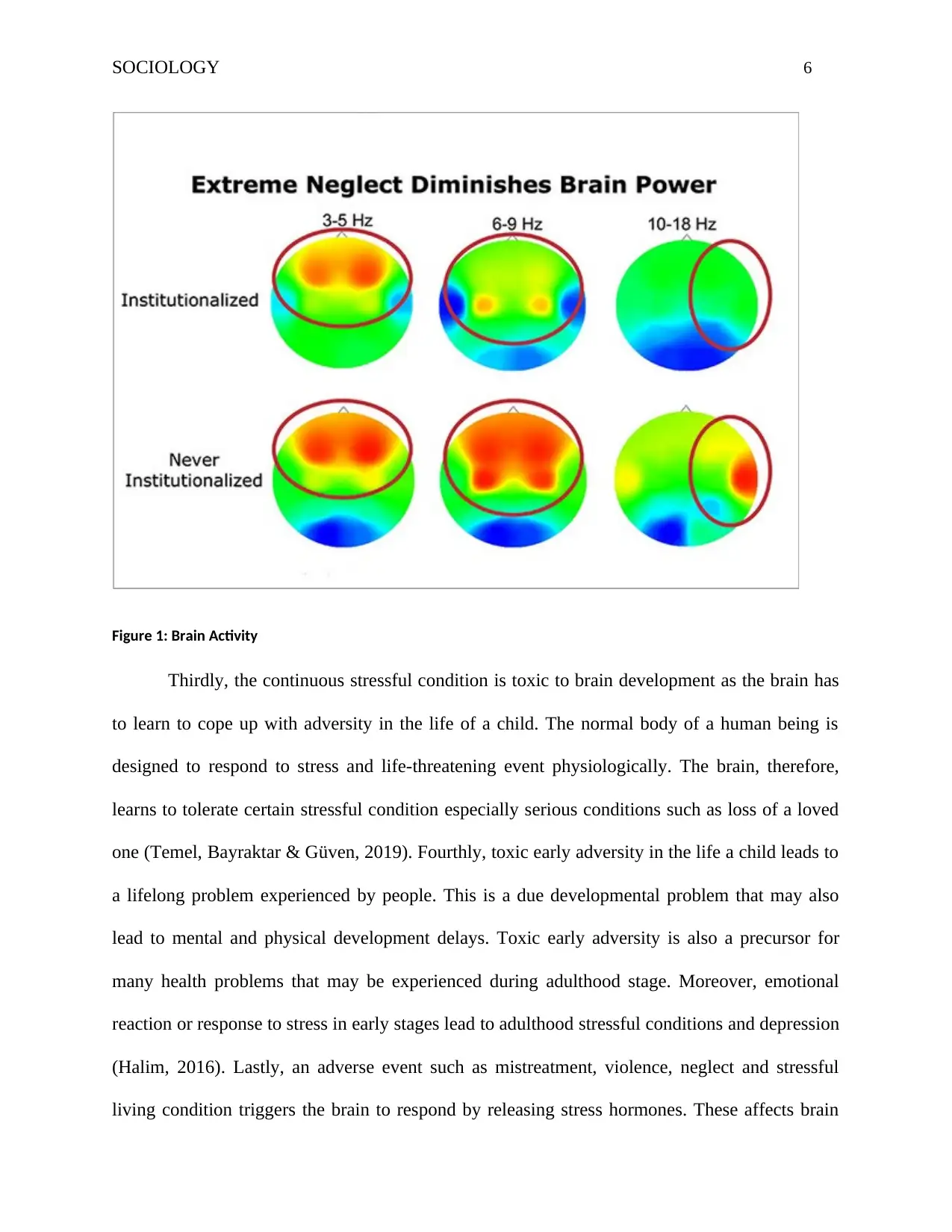
SOCIOLOGY 6
Figure 1: Brain Activity
Thirdly, the continuous stressful condition is toxic to brain development as the brain has
to learn to cope up with adversity in the life of a child. The normal body of a human being is
designed to respond to stress and life-threatening event physiologically. The brain, therefore,
learns to tolerate certain stressful condition especially serious conditions such as loss of a loved
one (Temel, Bayraktar & Güven, 2019). Fourthly, toxic early adversity in the life a child leads to
a lifelong problem experienced by people. This is a due developmental problem that may also
lead to mental and physical development delays. Toxic early adversity is also a precursor for
many health problems that may be experienced during adulthood stage. Moreover, emotional
reaction or response to stress in early stages lead to adulthood stressful conditions and depression
(Halim, 2016). Lastly, an adverse event such as mistreatment, violence, neglect and stressful
living condition triggers the brain to respond by releasing stress hormones. These affects brain
Figure 1: Brain Activity
Thirdly, the continuous stressful condition is toxic to brain development as the brain has
to learn to cope up with adversity in the life of a child. The normal body of a human being is
designed to respond to stress and life-threatening event physiologically. The brain, therefore,
learns to tolerate certain stressful condition especially serious conditions such as loss of a loved
one (Temel, Bayraktar & Güven, 2019). Fourthly, toxic early adversity in the life a child leads to
a lifelong problem experienced by people. This is a due developmental problem that may also
lead to mental and physical development delays. Toxic early adversity is also a precursor for
many health problems that may be experienced during adulthood stage. Moreover, emotional
reaction or response to stress in early stages lead to adulthood stressful conditions and depression
(Halim, 2016). Lastly, an adverse event such as mistreatment, violence, neglect and stressful
living condition triggers the brain to respond by releasing stress hormones. These affects brain
⊘ This is a preview!⊘
Do you want full access?
Subscribe today to unlock all pages.

Trusted by 1+ million students worldwide
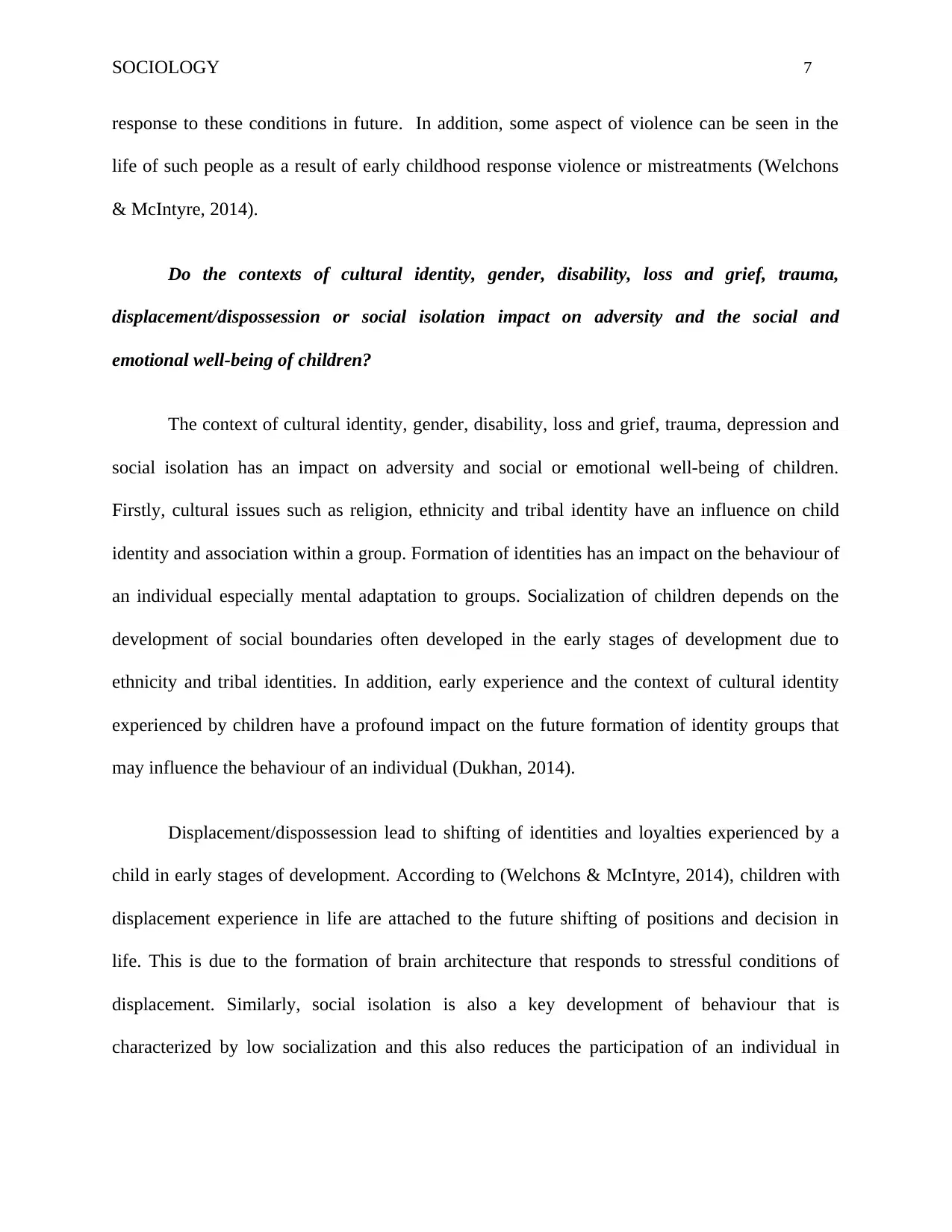
SOCIOLOGY 7
response to these conditions in future. In addition, some aspect of violence can be seen in the
life of such people as a result of early childhood response violence or mistreatments (Welchons
& McIntyre, 2014).
Do the contexts of cultural identity, gender, disability, loss and grief, trauma,
displacement/dispossession or social isolation impact on adversity and the social and
emotional well-being of children?
The context of cultural identity, gender, disability, loss and grief, trauma, depression and
social isolation has an impact on adversity and social or emotional well-being of children.
Firstly, cultural issues such as religion, ethnicity and tribal identity have an influence on child
identity and association within a group. Formation of identities has an impact on the behaviour of
an individual especially mental adaptation to groups. Socialization of children depends on the
development of social boundaries often developed in the early stages of development due to
ethnicity and tribal identities. In addition, early experience and the context of cultural identity
experienced by children have a profound impact on the future formation of identity groups that
may influence the behaviour of an individual (Dukhan, 2014).
Displacement/dispossession lead to shifting of identities and loyalties experienced by a
child in early stages of development. According to (Welchons & McIntyre, 2014), children with
displacement experience in life are attached to the future shifting of positions and decision in
life. This is due to the formation of brain architecture that responds to stressful conditions of
displacement. Similarly, social isolation is also a key development of behaviour that is
characterized by low socialization and this also reduces the participation of an individual in
response to these conditions in future. In addition, some aspect of violence can be seen in the
life of such people as a result of early childhood response violence or mistreatments (Welchons
& McIntyre, 2014).
Do the contexts of cultural identity, gender, disability, loss and grief, trauma,
displacement/dispossession or social isolation impact on adversity and the social and
emotional well-being of children?
The context of cultural identity, gender, disability, loss and grief, trauma, depression and
social isolation has an impact on adversity and social or emotional well-being of children.
Firstly, cultural issues such as religion, ethnicity and tribal identity have an influence on child
identity and association within a group. Formation of identities has an impact on the behaviour of
an individual especially mental adaptation to groups. Socialization of children depends on the
development of social boundaries often developed in the early stages of development due to
ethnicity and tribal identities. In addition, early experience and the context of cultural identity
experienced by children have a profound impact on the future formation of identity groups that
may influence the behaviour of an individual (Dukhan, 2014).
Displacement/dispossession lead to shifting of identities and loyalties experienced by a
child in early stages of development. According to (Welchons & McIntyre, 2014), children with
displacement experience in life are attached to the future shifting of positions and decision in
life. This is due to the formation of brain architecture that responds to stressful conditions of
displacement. Similarly, social isolation is also a key development of behaviour that is
characterized by low socialization and this also reduces the participation of an individual in
Paraphrase This Document
Need a fresh take? Get an instant paraphrase of this document with our AI Paraphraser
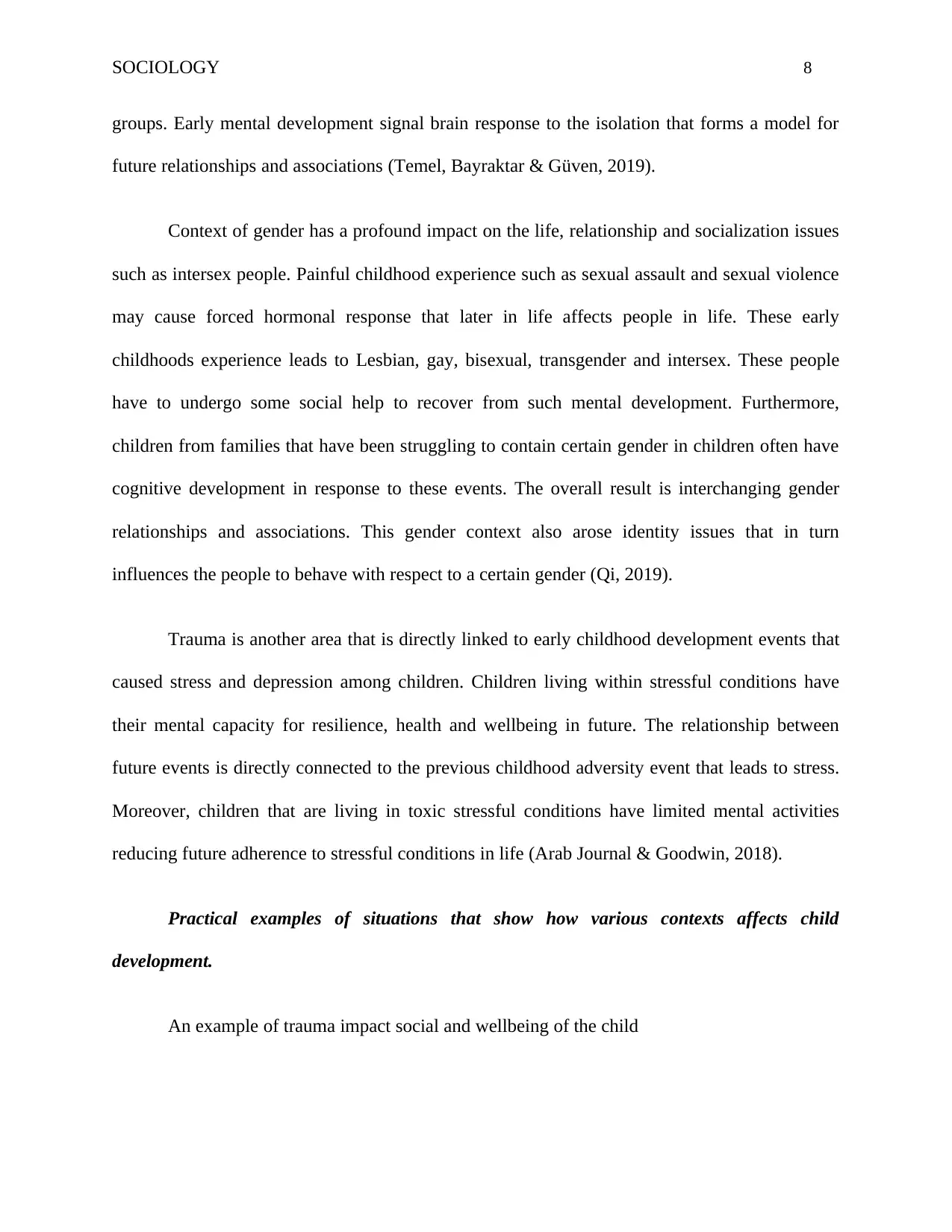
SOCIOLOGY 8
groups. Early mental development signal brain response to the isolation that forms a model for
future relationships and associations (Temel, Bayraktar & Güven, 2019).
Context of gender has a profound impact on the life, relationship and socialization issues
such as intersex people. Painful childhood experience such as sexual assault and sexual violence
may cause forced hormonal response that later in life affects people in life. These early
childhoods experience leads to Lesbian, gay, bisexual, transgender and intersex. These people
have to undergo some social help to recover from such mental development. Furthermore,
children from families that have been struggling to contain certain gender in children often have
cognitive development in response to these events. The overall result is interchanging gender
relationships and associations. This gender context also arose identity issues that in turn
influences the people to behave with respect to a certain gender (Qi, 2019).
Trauma is another area that is directly linked to early childhood development events that
caused stress and depression among children. Children living within stressful conditions have
their mental capacity for resilience, health and wellbeing in future. The relationship between
future events is directly connected to the previous childhood adversity event that leads to stress.
Moreover, children that are living in toxic stressful conditions have limited mental activities
reducing future adherence to stressful conditions in life (Arab Journal & Goodwin, 2018).
Practical examples of situations that show how various contexts affects child
development.
An example of trauma impact social and wellbeing of the child
groups. Early mental development signal brain response to the isolation that forms a model for
future relationships and associations (Temel, Bayraktar & Güven, 2019).
Context of gender has a profound impact on the life, relationship and socialization issues
such as intersex people. Painful childhood experience such as sexual assault and sexual violence
may cause forced hormonal response that later in life affects people in life. These early
childhoods experience leads to Lesbian, gay, bisexual, transgender and intersex. These people
have to undergo some social help to recover from such mental development. Furthermore,
children from families that have been struggling to contain certain gender in children often have
cognitive development in response to these events. The overall result is interchanging gender
relationships and associations. This gender context also arose identity issues that in turn
influences the people to behave with respect to a certain gender (Qi, 2019).
Trauma is another area that is directly linked to early childhood development events that
caused stress and depression among children. Children living within stressful conditions have
their mental capacity for resilience, health and wellbeing in future. The relationship between
future events is directly connected to the previous childhood adversity event that leads to stress.
Moreover, children that are living in toxic stressful conditions have limited mental activities
reducing future adherence to stressful conditions in life (Arab Journal & Goodwin, 2018).
Practical examples of situations that show how various contexts affects child
development.
An example of trauma impact social and wellbeing of the child
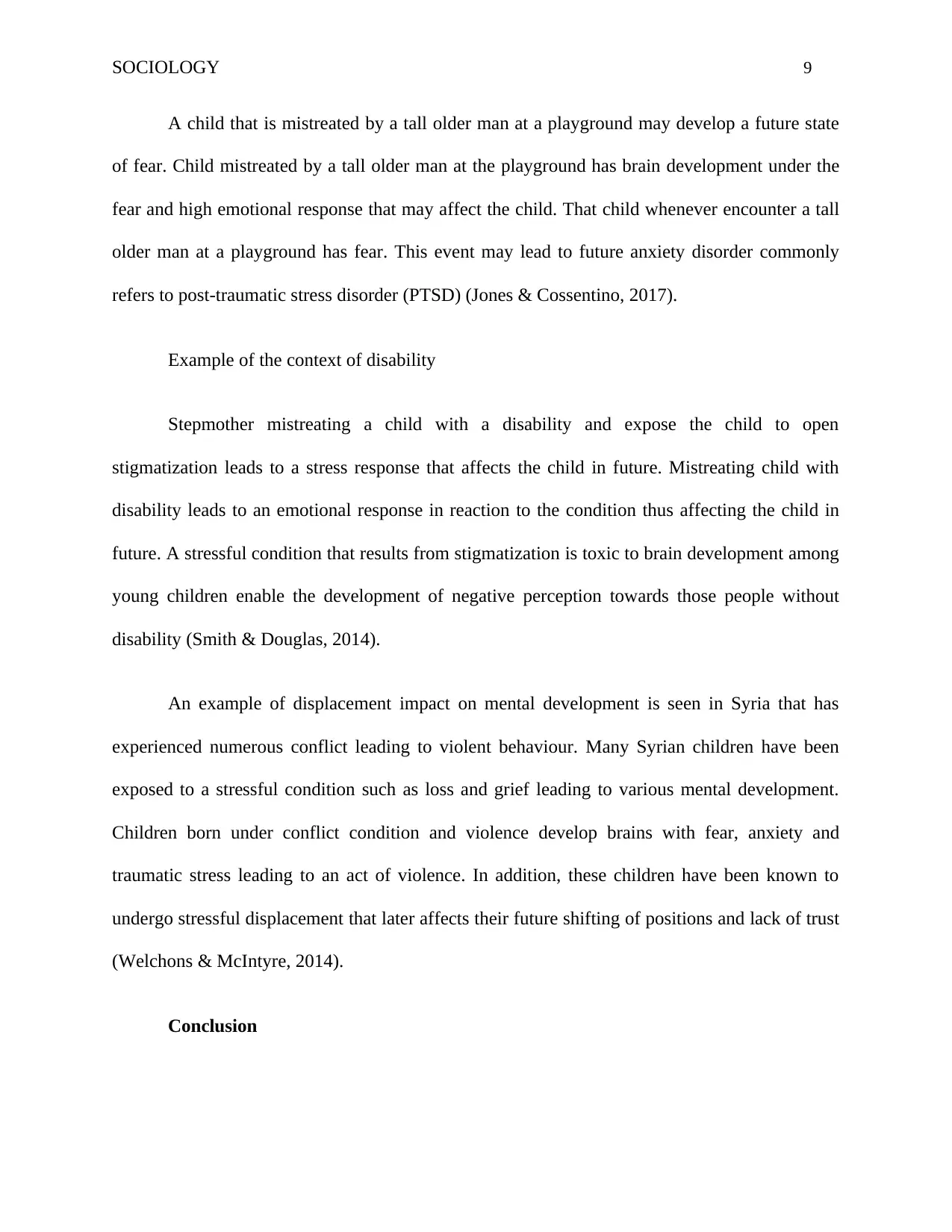
SOCIOLOGY 9
A child that is mistreated by a tall older man at a playground may develop a future state
of fear. Child mistreated by a tall older man at the playground has brain development under the
fear and high emotional response that may affect the child. That child whenever encounter a tall
older man at a playground has fear. This event may lead to future anxiety disorder commonly
refers to post-traumatic stress disorder (PTSD) (Jones & Cossentino, 2017).
Example of the context of disability
Stepmother mistreating a child with a disability and expose the child to open
stigmatization leads to a stress response that affects the child in future. Mistreating child with
disability leads to an emotional response in reaction to the condition thus affecting the child in
future. A stressful condition that results from stigmatization is toxic to brain development among
young children enable the development of negative perception towards those people without
disability (Smith & Douglas, 2014).
An example of displacement impact on mental development is seen in Syria that has
experienced numerous conflict leading to violent behaviour. Many Syrian children have been
exposed to a stressful condition such as loss and grief leading to various mental development.
Children born under conflict condition and violence develop brains with fear, anxiety and
traumatic stress leading to an act of violence. In addition, these children have been known to
undergo stressful displacement that later affects their future shifting of positions and lack of trust
(Welchons & McIntyre, 2014).
Conclusion
A child that is mistreated by a tall older man at a playground may develop a future state
of fear. Child mistreated by a tall older man at the playground has brain development under the
fear and high emotional response that may affect the child. That child whenever encounter a tall
older man at a playground has fear. This event may lead to future anxiety disorder commonly
refers to post-traumatic stress disorder (PTSD) (Jones & Cossentino, 2017).
Example of the context of disability
Stepmother mistreating a child with a disability and expose the child to open
stigmatization leads to a stress response that affects the child in future. Mistreating child with
disability leads to an emotional response in reaction to the condition thus affecting the child in
future. A stressful condition that results from stigmatization is toxic to brain development among
young children enable the development of negative perception towards those people without
disability (Smith & Douglas, 2014).
An example of displacement impact on mental development is seen in Syria that has
experienced numerous conflict leading to violent behaviour. Many Syrian children have been
exposed to a stressful condition such as loss and grief leading to various mental development.
Children born under conflict condition and violence develop brains with fear, anxiety and
traumatic stress leading to an act of violence. In addition, these children have been known to
undergo stressful displacement that later affects their future shifting of positions and lack of trust
(Welchons & McIntyre, 2014).
Conclusion
⊘ This is a preview!⊘
Do you want full access?
Subscribe today to unlock all pages.

Trusted by 1+ million students worldwide
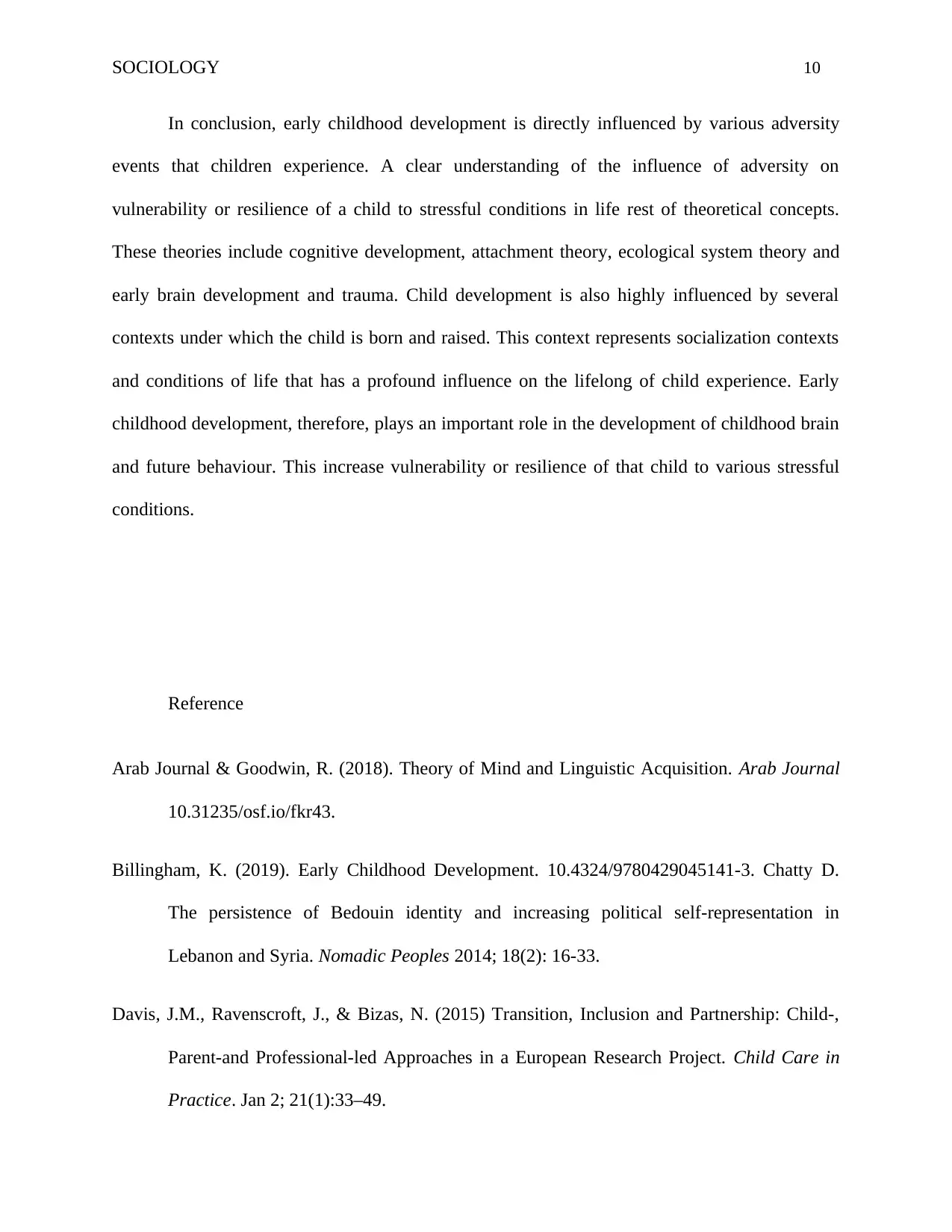
SOCIOLOGY 10
In conclusion, early childhood development is directly influenced by various adversity
events that children experience. A clear understanding of the influence of adversity on
vulnerability or resilience of a child to stressful conditions in life rest of theoretical concepts.
These theories include cognitive development, attachment theory, ecological system theory and
early brain development and trauma. Child development is also highly influenced by several
contexts under which the child is born and raised. This context represents socialization contexts
and conditions of life that has a profound influence on the lifelong of child experience. Early
childhood development, therefore, plays an important role in the development of childhood brain
and future behaviour. This increase vulnerability or resilience of that child to various stressful
conditions.
Reference
Arab Journal & Goodwin, R. (2018). Theory of Mind and Linguistic Acquisition. Arab Journal
10.31235/osf.io/fkr43.
Billingham, K. (2019). Early Childhood Development. 10.4324/9780429045141-3. Chatty D.
The persistence of Bedouin identity and increasing political self-representation in
Lebanon and Syria. Nomadic Peoples 2014; 18(2): 16-33.
Davis, J.M., Ravenscroft, J., & Bizas, N. (2015) Transition, Inclusion and Partnership: Child-,
Parent-and Professional-led Approaches in a European Research Project. Child Care in
Practice. Jan 2; 21(1):33–49.
In conclusion, early childhood development is directly influenced by various adversity
events that children experience. A clear understanding of the influence of adversity on
vulnerability or resilience of a child to stressful conditions in life rest of theoretical concepts.
These theories include cognitive development, attachment theory, ecological system theory and
early brain development and trauma. Child development is also highly influenced by several
contexts under which the child is born and raised. This context represents socialization contexts
and conditions of life that has a profound influence on the lifelong of child experience. Early
childhood development, therefore, plays an important role in the development of childhood brain
and future behaviour. This increase vulnerability or resilience of that child to various stressful
conditions.
Reference
Arab Journal & Goodwin, R. (2018). Theory of Mind and Linguistic Acquisition. Arab Journal
10.31235/osf.io/fkr43.
Billingham, K. (2019). Early Childhood Development. 10.4324/9780429045141-3. Chatty D.
The persistence of Bedouin identity and increasing political self-representation in
Lebanon and Syria. Nomadic Peoples 2014; 18(2): 16-33.
Davis, J.M., Ravenscroft, J., & Bizas, N. (2015) Transition, Inclusion and Partnership: Child-,
Parent-and Professional-led Approaches in a European Research Project. Child Care in
Practice. Jan 2; 21(1):33–49.
Paraphrase This Document
Need a fresh take? Get an instant paraphrase of this document with our AI Paraphraser
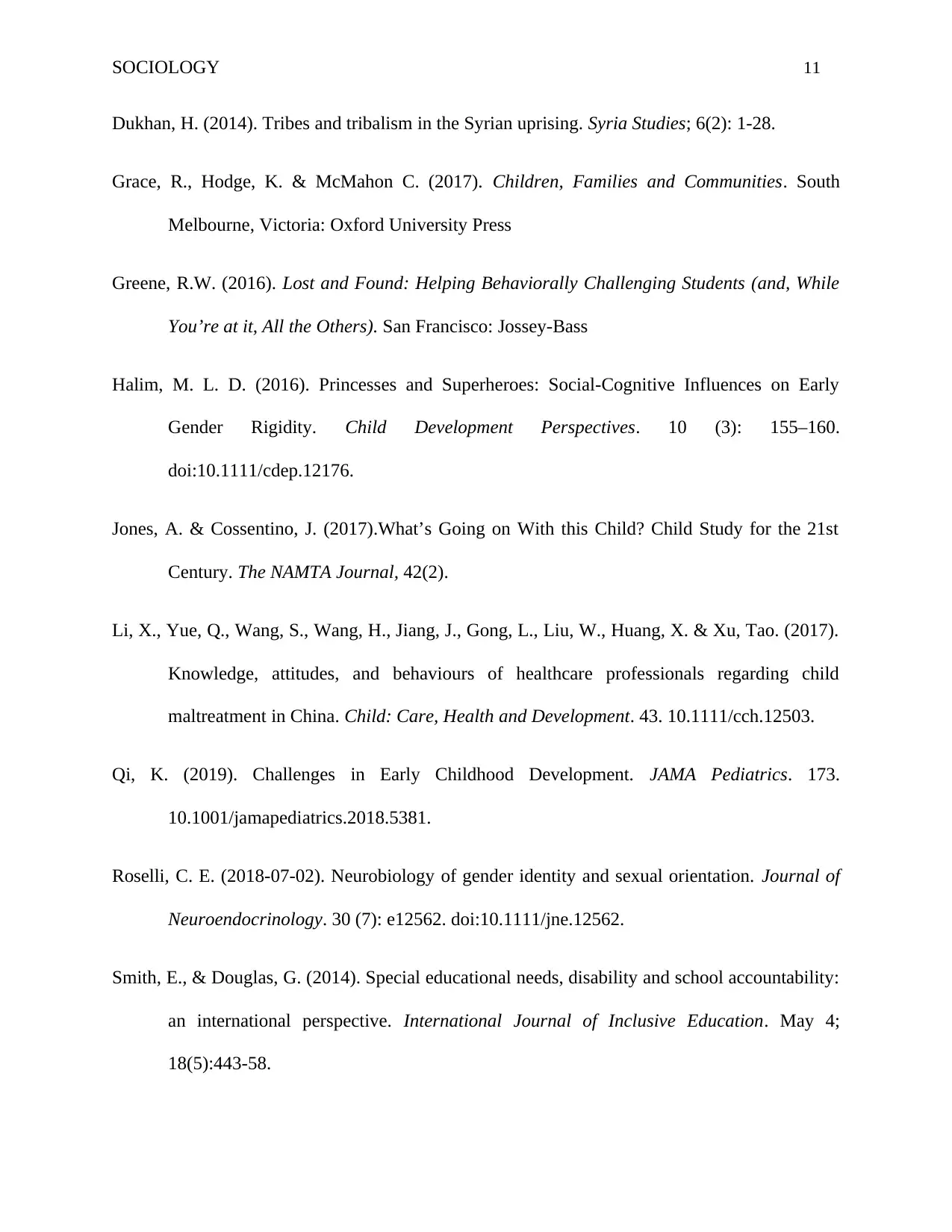
SOCIOLOGY 11
Dukhan, H. (2014). Tribes and tribalism in the Syrian uprising. Syria Studies; 6(2): 1-28.
Grace, R., Hodge, K. & McMahon C. (2017). Children, Families and Communities. South
Melbourne, Victoria: Oxford University Press
Greene, R.W. (2016). Lost and Found: Helping Behaviorally Challenging Students (and, While
You’re at it, All the Others). San Francisco: Jossey-Bass
Halim, M. L. D. (2016). Princesses and Superheroes: Social-Cognitive Influences on Early
Gender Rigidity. Child Development Perspectives. 10 (3): 155–160.
doi:10.1111/cdep.12176.
Jones, A. & Cossentino, J. (2017).What’s Going on With this Child? Child Study for the 21st
Century. The NAMTA Journal, 42(2).
Li, X., Yue, Q., Wang, S., Wang, H., Jiang, J., Gong, L., Liu, W., Huang, X. & Xu, Tao. (2017).
Knowledge, attitudes, and behaviours of healthcare professionals regarding child
maltreatment in China. Child: Care, Health and Development. 43. 10.1111/cch.12503.
Qi, K. (2019). Challenges in Early Childhood Development. JAMA Pediatrics. 173.
10.1001/jamapediatrics.2018.5381.
Roselli, C. E. (2018-07-02). Neurobiology of gender identity and sexual orientation. Journal of
Neuroendocrinology. 30 (7): e12562. doi:10.1111/jne.12562.
Smith, E., & Douglas, G. (2014). Special educational needs, disability and school accountability:
an international perspective. International Journal of Inclusive Education. May 4;
18(5):443-58.
Dukhan, H. (2014). Tribes and tribalism in the Syrian uprising. Syria Studies; 6(2): 1-28.
Grace, R., Hodge, K. & McMahon C. (2017). Children, Families and Communities. South
Melbourne, Victoria: Oxford University Press
Greene, R.W. (2016). Lost and Found: Helping Behaviorally Challenging Students (and, While
You’re at it, All the Others). San Francisco: Jossey-Bass
Halim, M. L. D. (2016). Princesses and Superheroes: Social-Cognitive Influences on Early
Gender Rigidity. Child Development Perspectives. 10 (3): 155–160.
doi:10.1111/cdep.12176.
Jones, A. & Cossentino, J. (2017).What’s Going on With this Child? Child Study for the 21st
Century. The NAMTA Journal, 42(2).
Li, X., Yue, Q., Wang, S., Wang, H., Jiang, J., Gong, L., Liu, W., Huang, X. & Xu, Tao. (2017).
Knowledge, attitudes, and behaviours of healthcare professionals regarding child
maltreatment in China. Child: Care, Health and Development. 43. 10.1111/cch.12503.
Qi, K. (2019). Challenges in Early Childhood Development. JAMA Pediatrics. 173.
10.1001/jamapediatrics.2018.5381.
Roselli, C. E. (2018-07-02). Neurobiology of gender identity and sexual orientation. Journal of
Neuroendocrinology. 30 (7): e12562. doi:10.1111/jne.12562.
Smith, E., & Douglas, G. (2014). Special educational needs, disability and school accountability:
an international perspective. International Journal of Inclusive Education. May 4;
18(5):443-58.
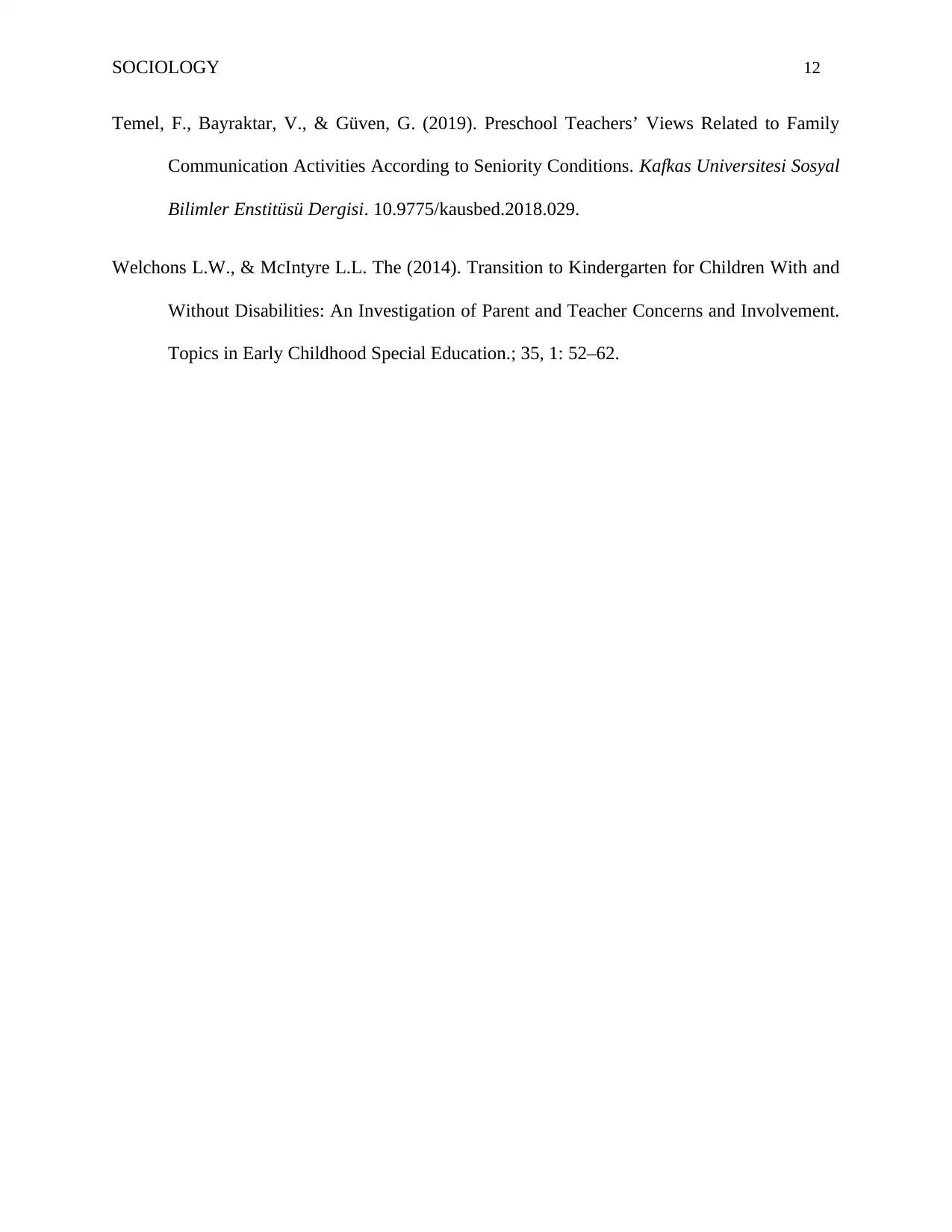
SOCIOLOGY 12
Temel, F., Bayraktar, V., & Güven, G. (2019). Preschool Teachers’ Views Related to Family
Communication Activities According to Seniority Conditions. Kafkas Universitesi Sosyal
Bilimler Enstitüsü Dergisi. 10.9775/kausbed.2018.029.
Welchons L.W., & McIntyre L.L. The (2014). Transition to Kindergarten for Children With and
Without Disabilities: An Investigation of Parent and Teacher Concerns and Involvement.
Topics in Early Childhood Special Education.; 35, 1: 52–62.
Temel, F., Bayraktar, V., & Güven, G. (2019). Preschool Teachers’ Views Related to Family
Communication Activities According to Seniority Conditions. Kafkas Universitesi Sosyal
Bilimler Enstitüsü Dergisi. 10.9775/kausbed.2018.029.
Welchons L.W., & McIntyre L.L. The (2014). Transition to Kindergarten for Children With and
Without Disabilities: An Investigation of Parent and Teacher Concerns and Involvement.
Topics in Early Childhood Special Education.; 35, 1: 52–62.
⊘ This is a preview!⊘
Do you want full access?
Subscribe today to unlock all pages.

Trusted by 1+ million students worldwide
1 out of 12
Related Documents
Your All-in-One AI-Powered Toolkit for Academic Success.
+13062052269
info@desklib.com
Available 24*7 on WhatsApp / Email
![[object Object]](/_next/static/media/star-bottom.7253800d.svg)
Unlock your academic potential
Copyright © 2020–2025 A2Z Services. All Rights Reserved. Developed and managed by ZUCOL.





